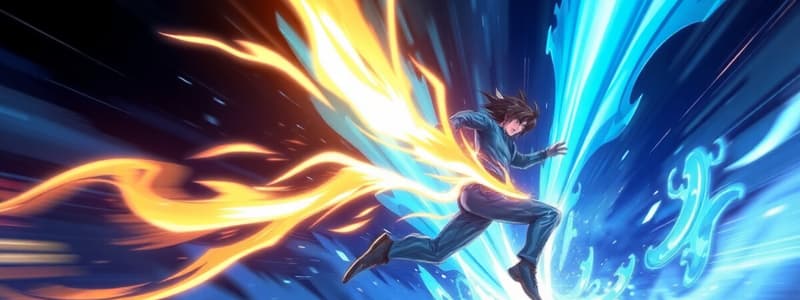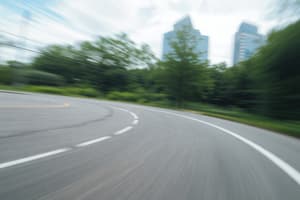Podcast
Questions and Answers
A car moving at a constant speed is an example of:
A car moving at a constant speed is an example of:
- Accelerated motion
- Decelerated motion
- Non-uniform motion
- Uniform motion (correct)
Which of the following is NOT a source of light?
Which of the following is NOT a source of light?
- A light bulb
- The sun
- A candle
- A mirror (correct)
Sound travels fastest through which of these?
Sound travels fastest through which of these?
- Water
- Air
- Steel (correct)
- Vacuum
What happens to a metal spoon when it's heated?
What happens to a metal spoon when it's heated?
Which of the following is NOT a good conductor of electricity?
Which of the following is NOT a good conductor of electricity?
Flashcards
Motion of Objects
Motion of Objects
The change in position of an object over time due to a force.
Sources of Light
Sources of Light
Objects that emit light, such as the sun, bulbs, or fire.
Uses of Sound
Uses of Sound
Sound waves are used for communication, music, and alerts.
Sources of Heat
Sources of Heat
Signup and view all the flashcards
Uses of Electricity
Uses of Electricity
Signup and view all the flashcards
Study Notes
Motion of Objects
- Types of Motion:
- Rectilinear motion: Movement along a straight line.
- Curvilinear motion: Movement along a curved path.
- Rotational motion: Movement around a central point or axis.
- Periodic motion: Movement that repeats itself at regular intervals.
- Random motion: Movement with no specific pattern or direction.
- Factors Affecting Motion:
- Force: A push or pull that can change the state of motion of an object.
- Friction: A force that opposes motion between two surfaces in contact.
- Gravity: The force that attracts objects with mass towards each other.
- Inertia: The tendency of an object to resist changes in its state of motion.
- Describing Motion:
- Speed: The rate at which an object covers a certain distance per unit time.
- Velocity: The rate of change of position of an object with respect to time, with direction specified.
- Acceleration: The rate of change of velocity of an object with respect to time.
- Examples of Motion in Everyday Life:
- A car moving along a road.
- A ball rolling across the floor.
- A pendulum swinging back and forth.
- The Earth orbiting the Sun.
Sources and Uses of Light
- Sources of Light:
- Natural sources: The Sun, stars, fireflies.
- Artificial sources: Light bulbs, candles, flashlights.
- Properties of Light:
- Light travels in straight lines.
- Light can be reflected.
- Light can be refracted.
- Light can be absorbed.
- Light has a spectrum of colours and different wavelengths related to their colours.
- Uses of Light:
- Vision and seeing objects.
- Photosynthesis in plants.
- Heating purposes (e.g., solar energy).
- Communication technologies (e.g., fibre optics).
- Lighting for tasks and activities.
- Safety (e.g., traffic signals, emergency lights).
- Entertainment (e.g., stage lighting, lasers).
Sources and Uses of Sound
- Sources of Sound:
- Vibrating objects: Tuning forks, guitars, vocal cords.
- Moving objects: Sirens, explosions.
- Natural phenomena: Thunder, wind.
- Properties of Sound:
- Sound needs a medium to travel (solid, liquid, gas).
- Sound travels faster in solids than in liquids, and faster in liquids than in gases.
- Sound is characterized by pitch (frequency) and loudness (amplitude).
- Sound waves have crests and troughs.
- Uses of Sound:
- Communication (talking, hearing).
- Musical instruments.
- Medical imaging (ultrasound).
- Navigation (sonar).
- Warning signals (alarms, horns).
Sources and Uses of Heat
- Sources of Heat:
- Sun
- Fire
- Burning fuels
- Electricity
- Friction
- Methods of Heat Transfer:
- Conduction: Heat transfer through direct contact (e.g., touching a hot stove).
- Convection: Heat transfer through the movement of fluids (e.g., boiling water).
- Radiation: Heat transfer through electromagnetic waves (e.g., feeling the heat from the Sun).
- Uses of Heat:
- Cooking food
- Heating houses and buildings
- Industrial processes
- Power generation
- Manufacturing (metallurgy).
- Medical sterilisation.
Sources and Uses of Electricity
- Sources of Electricity:
- Batteries: Chemical reactions.
- Generators: Mechanical energy.
- Solar panels: Sunlight.
- Nuclear reactions (limited school context).
- Electric Circuits:
- Closed circuits are essential for electricity to flow.
- Conductors allow electricity to flow.
- Insulators do not allow electricity to flow.
- Uses of Electricity:
- Lighting homes and streets.
- Heating and cooling homes.
- Running appliances.
- Powering communications systems (computers, mobile phones).
- Electrical systems in cars and vehicles.
- Manufacturing and industrial processes.
- Safety Precautions:
- Avoid touching exposed wires.
- Use proper tools for electrical work.
- Inspect electrical equipment regularly.
General Grade 3 Learning Competencies (Concepts for testing)
- Identifying properties of different materials and their applications based on the given properties.
- Describing the motion of objects (uniform motion, changing motion)
- Identifying different sources of light and their uses
- Identifying different sources of sound and their uses
- Identifying different sources of heat and their uses
- Identifying different sources of electricity and their uses.
- Recognizing the energy transformation in different situations (light, sound, heat and motion)
- Locating simple sources of energy
- Designing and constructing simple machines or devices utilizing light, sound, heat and electricity.
- Explaining the relationship between observed phenomena and scientific concepts
Studying That Suits You
Use AI to generate personalized quizzes and flashcards to suit your learning preferences.




